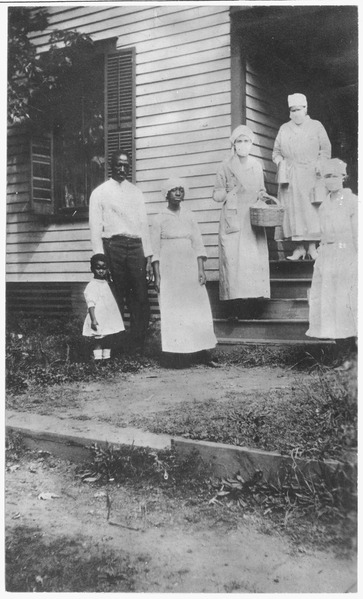
Ryan Brown, an economics doctoral candidate in DuPRI’s National Institute on Aging-funded training program, has received the Minnesota Population Center's 2012 IPUMS-USA Research Award for the "best published or unpublished work by a graduate student." His paper titled, "On the Long Term Effects of the 1918 U.S. Influenza Pandemic," is based on the Center's U.S. Census microdata series and was unanimously selected by the MPC panel for the recognition.
Brown's as yet unpublished study, written with Economics professor and DUPRI Fellow Duncan Thomas, examines the socioeconomic backgrounds of the cohort of U.S. children who were in utero during the flu pandemic of 1918-1919 and tests a theory that these kids suffered particular hardships, even into old age, as a result of that early-life exposure. The paper shows how challenging a single assumption in a prior analysis can alter its results dramatically.
Brown's paper was not an attempt to challenge the idea that early-life exposures can cause permanent harm, he cautions, but rather a reminder to fellow economists that, "We need to think really hard about how we go about using natural experiments. It's really important to have strong theory behind it, and to take your assumptions very seriously, because they are that, they are assumptions."
In 2006, amid heightened concern over the possibility that a new strain of avian influenza could morph into a global human flu pandemic to rival the Great Influenza, Columbia University economist Douglas Almond published his analysis showing the lifelong disadvantages experienced by the babies born in the U.S. during and just after the 1918-1919 crisis. They had fewer years of education, earned less as adults and had more disability late in life.
Evidence from biology and epidemiology strongly supports the idea that prenatal exposures—whether to exogenous chemicals, disease or other forms of maternal stress—can impact a developing fetus in ways that may harm its health and fitness for a lifetime. And a growing body of research suggests that such developmental deficits can lead to real social and economic losses.
Almond argued that the 1918 pandemic was an ideal natural experiment for identifying these long-term consequences of an early exposure because the flu infected about a third of the U.S. population, including a slightly higher proportion of pregnant women. The pandemic came on suddenly, lasted for a relatively short and clearly defined period, and its spread appeared to be geographically random—no part of the nation was spared.
Brown and Thomas have shown, however, that the fate of being a fetus during the great pandemic was anything but random. They write: "A key assumption underlying [Almond's study] is that the characteristics of the 1919 birth cohort are following the same linear trend as the surrounding birth cohorts."
In fact, the authors remind us, there was still a war going on at the time the flu hit in 1918, and in that era wealth and education made men more eligible for military service, not less so. An exemption from service for sole providers whose absence would cause severe financial hardship was more likely to favor the breadwinners of poorer families than those with ample resources. That meant the men left behind to potentially father children in 1918 were likely of lower socioeconomic status. Together with the fact that higher-status families are more prone and better able to delay childbearing during a period of crisis and uncertainty, Brown and Thomas argue that the family backgrounds of the 1919 birth cohort are a key variable to consider when examining their later-life outcomes.

1918: Red Cross nurses bring food to a Charlotte, NC, family that has just lost its wife and mother to influenza. (Source: U.S. National Archives and Records Administration)
Using data from the IPUMS samples of the 1920 and 1930 U.S. Censuses, they show "that those who were at highest risk of being exposed in utero were born to families of lower socio-economic status relative to the cohorts who were not exposed. Specifically, the fathers that produced a child in 1919 were significantly less likely to be WWI veterans, had jobs that produced less income, had lower socioeconomic status (SES), were older, had more total children, and were less likely to be white than fathers of those who were not at high risk of being exposed to influenza in utero."
As a result, they write of Almond's original analysis, "When including controls for childhood environment, the effect of in utero exposure on adult outcomes becomes small in magnitude and not statistically significant. Conclusions about the deleterious impact of in utero exposure to the influenza pandemic on socio-economic prosperity in adulthood are, at best, premature."
The issue, Brown says, is not that the 1919 cohort was particularly unlucky. On the contrary, "it's that they're just a different set of children, born to less well off parents, and when you compare them to the mixture [of children born before and after the pandemic], it makes them look bad. But when you compare them to a similar group by controlling for the parents' characteristics, it looks like they're doing just as well."
He and Thomas cannot speak to why the exposed cohort appear to be doing as well as the unexposed, and the authors are careful not to imply that being a pandemic baby had no ripple effects. But they conclude on a positive note that their findings at least suggest there is room for mitigating interventions later in life that could offset an early exposure.
Brown was drawn to Almond's paper because it was widely considered the strongest evidence of the potential for prenatal exposures to influence success throughout life. "And the topic itself is one I find incredibly interesting, the idea that things that can happen to us in utero can have such long-lasting and serious effects," he says. "I don't know if everyone is aware that's the case. We think a lot about helping the next generation, but I don't think we think about helping the next generation in utero.... It brings up a lot of interesting questions, so since this was the seminal work, I thought it was worthwhile to think deeply about it."
Brown credits mentoring by Thomas and DUPRI director Seth Sanders with "shaping the economist I am today" and instilling an appreciation for the importance of scientific rigor. Unlike the so-called hard sciences, he says, "We have to deal with a lot of confounding factors that there's no way to control, which does make social science a bit more challenging and brings back the issue of doing your best to look under every rock to make sure the assumptions you're making are valid."
His interest in natural experiments - and in testing their validity for answering specific questions - extends to another ongoing research project to examine the effects of maternal psychological stress on health outcomes for babies in utero during the terrorist attacks of September 11, 2001.
Brown, who will be working on completing his dissertation this summer and hitting the job market in the fall says of his IPUMS-USA Research Award, "Every time your peers say something you've done is worthwhile, and worth checking out, that means a lot. You work really hard on these things, and you really have your head down trying to get it right. It's nice when people you respect as your peers respect what you've done."